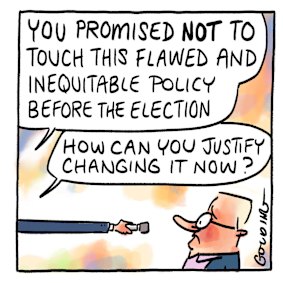The 80,000 Australians with superannuation balances above $3 million have two years to find a workaround on the government’s planned doubling of tax. Realistically, it won’t take them that long.
Accountants working for higher net worth individuals are already fielding calls for advice on how to avoid being slugged by the additional tax, says Tony Negline, superannuation and financial leader for Chartered Accountants Australia and New Zealand.

The government has pencilled in raising $2 billion a year from the super tax change, but many high-wealth people will be seeking alternative investments.Credit:Karl Hilzinger
On the face of Tuesday’s announcement, any super balances below $3 million will still attract only 15 per cent tax. There is no reason to leave money exceeding that amount in the nest egg, because it will attract a 30 per cent tax rate.
The reality is, people with balances above $3 million will have access to financial and tax advice that will allow them to find alternative ways to invest their money.
Let’s assume you have $5 million – the question now becomes how to deal with $2 million in a tax-effective way.
The most obvious is to put money into your family home – an asset that is not subject to capital gains tax. Either upgrade to a more expensive house with the excess funds taken from super, or pay off any mortgage that is costing about 5 per cent in interest.
Let’s assume you have $5 million – the question becomes how to deal with $2 million in a tax-effective way.
In doing so, the $2 million that was attracting 15 per cent tax in super will attract no tax. That’s lost revenue for the government.
Another option, which may or may not pass muster because the fine print in the government’s proposal has yet to be announced, is to transfer money to a spouse who has a lower super balance.
In other words, if someone has a balance of $5 million and their spouse has only $1 million, the balances can be split, so both have only $3 million – a practice known as benefit splitting. Negline believes many people will “give this a stab”.
Yet another option would be to take the excess money out of super and invest it directly in shares. The trick here is to invest in securities that attract a fully franked dividend. If an investor receives franked shares, they are deemed to have already paid corporate tax.
In the hands of shareholders, a fully franked dividend will be taxed at the difference between the corporate tax rate of 30 per cent and the recipient’s top marginal tax rate.
If the dividend recipient’s tax rate is 30 per cent, they will pay no tax. If their marginal tax rate is below 30 per cent, they will get a tax refund.
Investing in shares carries a bit more risk, but there are a number of defensive, less risky stocks that consistently produce strong dividends – and, again, those with big super balances probably have access to financial advisers who can steer them towards the right picks.
The use of a family trust is another common avenue used by higher net worth individuals. The money taken from superannuation could be directed into the family trust and distributed to beneficiaries including a spouse or children who pay a lower rate of income tax.
Negline says the latest changes to tax on super balances are strongly skewed to older Australians, mostly to those over 75.
This is because the rules around superannuation have changed in two major ways over the past two decades.

Credit:Matt Golding
Under former treasurer Peter Costello, there was a limit placed on the size of contributions to super while attracting favourable tax rates, but there was no restriction on the size of balances. But in 2016 the Morrison government imposed a $1.6 million limit on the size of balances, later indexed to $1.7 million.
Thus, the 80,000 people with large balances affected by the Albanese government’s proposed tax change built those up in the early years, when super balances and contributions were unrestricted.
Given these demographics, those affected by the proposed changes could opt for distributing the excess through inheritance to children, grandchildren or charities.
As long as the person withdrawing the funds is over 60, they will not pay a tax penalty, nor will the recipient be taxed.
The government has pencilled in raising $2 billion a year from the latest super tax change, using what it considers to be reasonable assumptions about the number of people who will change behaviour, the number who won’t and the number of people who will die.
But as Negline says, these predictions are notoriously difficult to get right.
The Business Briefing newsletter delivers major stories, exclusive coverage and expert opinion. Sign up to get it every weekday morning.
Most Viewed in Money
https://news.google.com/rss/articles/CBMid2h0dHBzOi8vd3d3LnNtaC5jb20uYXUvbW9uZXkvdGF4L3RoZS1nb3Zlcm5tZW50LXMtbmV3LXN1cGVyLXJ1bGVzLWZpdmUtd2F5cy10by1hdm9pZC10aGUtZXh0cmEtdGF4LTIwMjMwMzAxLXA1Y29qZi5odG1s0gF3aHR0cHM6Ly9hbXAuc21oLmNvbS5hdS9tb25leS90YXgvdGhlLWdvdmVybm1lbnQtcy1uZXctc3VwZXItcnVsZXMtZml2ZS13YXlzLXRvLWF2b2lkLXRoZS1leHRyYS10YXgtMjAyMzAzMDEtcDVjb2pmLmh0bWw?oc=5
2023-03-01 04:19:26Z
1811730077
Bagikan Berita Ini














0 Response to "The government’s new super rules: Five ways to avoid the extra tax - Sydney Morning Herald"
Post a Comment